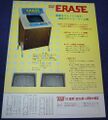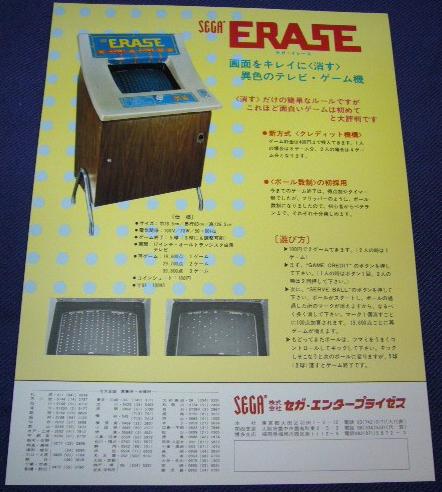Difference between revisions of "Erase"
From Sega Retro
Scarred Sun (talk | contribs) |
|||
| Line 1: | Line 1: | ||
| − | |||
{{Bob | {{Bob | ||
| bobscreen= | | bobscreen= | ||
| − | |||
| − | |||
| publisher=[[Sega]] | | publisher=[[Sega]] | ||
| developer=[[Ramtek]] | | developer=[[Ramtek]] | ||
| system=Discrete logic | | system=Discrete logic | ||
| − | |||
| sounddriver= | | sounddriver= | ||
| peripherals= | | peripherals= | ||
| Line 16: | Line 12: | ||
}} | }} | ||
}} | }} | ||
| − | {{sub-stub}}''''' | + | {{sub-stub}}'''''{{PAGENAME}}''''' (イレース) is a rebadged version of Ramtek's 1974 title ''Clean Sweep'' for Japanese audiences. |
| + | |||
==Gameplay== | ==Gameplay== | ||
Players try to erase a field of dots by directing a bouncing ball with a joystick-controlled "paddle" that is moved horizontally across the bottom of the screen. Each time the ball passes over a dot, the dot gets erase and the player gets a point. If they erase all the dots, they score a "clean sweep" and can win a free game. The game can be played by one or two players and allows for either 3 or 5 balls for each player. | Players try to erase a field of dots by directing a bouncing ball with a joystick-controlled "paddle" that is moved horizontally across the bottom of the screen. Each time the ball passes over a dot, the dot gets erase and the player gets a point. If they erase all the dots, they score a "clean sweep" and can win a free game. The game can be played by one or two players and allows for either 3 or 5 balls for each player. | ||
| + | |||
| + | ==Specifications== | ||
| + | ===Dimensions (Upright)=== | ||
| + | {{Dimensions|hm=1.56|wm=0.65|dm=0.59|diagramsize=150|ref={{ref|https://blog.goo.ne.jp/nazox2016/e/58e5dce24ca4f0ea7644aea801404d79}}}} | ||
| + | |||
| + | ===Dimensions (Midtype)=== | ||
| + | {{Dimensions|hm=1.27|wm=0.74|dm=0.63|diagramsize=150|ref={{ref|https://blog.goo.ne.jp/nazox2016/e/58e5dce24ca4f0ea7644aea801404d79}}}} | ||
==Promotional material== | ==Promotional material== | ||
| + | {{gallery | ||
| + | |{{gitem|Erase DL JP flyer.jpg|JP flyer}} | ||
| + | }} | ||
| + | |||
| + | ==Photo gallery== | ||
<gallery> | <gallery> | ||
| − | + | Erase cabinet1.jpg|Cabinet variant 1 | |
| + | Erase cabinet2.jpg|Cabinet variant 2 | ||
</gallery> | </gallery> | ||
==Physical scans== | ==Physical scans== | ||
| − | + | ||
| − | |||
| − | |||
| − | |||
==References== | ==References== | ||
| − | <references /> | + | <references/> |
Revision as of 10:06, 10 July 2018

| |||||||||
| Erase | |||||||||
|---|---|---|---|---|---|---|---|---|---|
| System(s): Discrete logic | |||||||||
| Publisher: Sega | |||||||||
| Developer: Ramtek | |||||||||
| Number of players: 1-2 | |||||||||
|
This teeny-tiny article needs some work. You can help us by expanding it.
Erase (イレース) is a rebadged version of Ramtek's 1974 title Clean Sweep for Japanese audiences.
Contents
Gameplay
Players try to erase a field of dots by directing a bouncing ball with a joystick-controlled "paddle" that is moved horizontally across the bottom of the screen. Each time the ball passes over a dot, the dot gets erase and the player gets a point. If they erase all the dots, they score a "clean sweep" and can win a free game. The game can be played by one or two players and allows for either 3 or 5 balls for each player.
Specifications
Dimensions (Upright)
Dimensions (Midtype)



